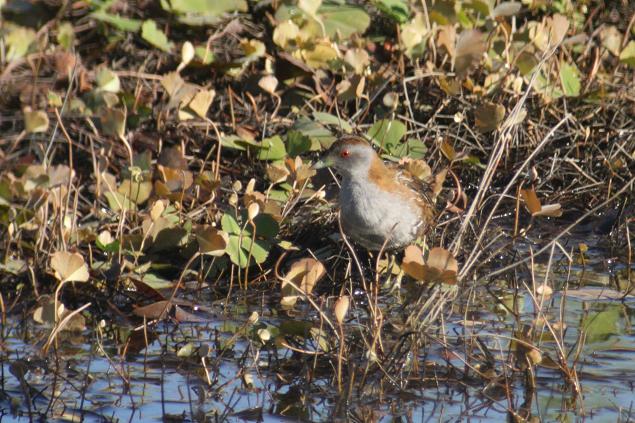A somewhat dismissive title, but today marked my 19th visit to Thompson Beach for the year. In the twelve months since I returned to live in Adelaide permanently, this has been the one site that I have visited most frequently. I've seen a bunch of great birds out there over the last 12 months and today was no exception - I added another unexpected species to my site list. This is the beauty of having a 'patch' that you visit frequently, you see the seasonal changes in species diversity, you witness the flurry of breeding activity and you sometimes get to observe the oddballs who blow in to town and are gone the very next week, day or (on occasion) the next minute!
Today was one of those days where I found a bunch of those birding 'oddballs' skulking about the furthest limits of Thompson Beach. At the very limit of beach access on the northern side of town, there's a tidal inlet with some dense stands of remnant Mangrove lining the banks. It looks like anything could be lurking about in there, well...almost anything. So, in recent visits I've made a concerted effort to spend more time in there trying to turn up something new for the site list. Today it paid off, out lurking about a small clump of regenerating Mangrove I found 4 Banded Lapwings. Not a new sighting for me but seeing them at a distance of 100 metres with the naked eye really got my heart pumping. Could it be? Really?
 |
| Banded Lapwing Vanellus tricolor |
Well, the excitement subsided once I had to nut-out how to get a decent picture of these somewhat nervous birds. The more I waddled toward them, the more noise they made. Eventually one took flight with all of the requisite 'kekking' reserved for a sunburned, fumbling intruder like me. Then the alarm calls of the first bird 'alarmed' the other three and they made off for more relaxing digs. Not before serenading me with a characteristic Lapwing cacophony and giving my ears a thorough arse-kekking!
The other thing I love about visiting the same site over time is that you really get a more intimate understanding of some birds that other people may dismiss as being too common, too plain or too difficult to get a good view of. For instance, I love being so engrossed in scoping and counting other waders only to eventually rest my eyes and realise I am almost surrounded by Red-necked Stints busily feeding about my feet. The beauty about this species is once you start looking for them you realise how many of them are spread over an incredible area of beach. Waders can be notoriously nervous and hard to get close to but given the right tidal conditions and some patience; some species, such as the Red-necked Stint, will happily go about their business with you quite close by. I love to follow these little birds with the scope as they scuttle about the shore on a falling tide, getting a gut-full of tasty morsels is if it were their last meal. In the world of Waders, Stints sure seem to display more of a 'caffeinated' approach to feeding and getting about.
 |
| Red-necked Stint Calidris ruficollis |
At the other end of what we will now refer to as the 'Wader Energy & Enthusiasm Spectrum' you have the 'blob' birds like the Greater and Lesser Sand Plovers. I've seen these perfectly pudgy little beach-goers a number of times at Thompson Beach but every time I see them they're doing the same thing.
Not too bloody much!
Wake up, fly to beach, sit amongst some rocks, squint at the sun, pose for some pictures - repeat.
 |
| "Hmmmmm......What to do?" |
Well, that may be a terrible over-simplification of things but you get the picture - some Waders seem to be 'doing it' while others are busy 'thinking about doing it'. One of my favourite Waders is the elegant and beautifully coloured Pacific Golden Plover. But, like their Sand Plover cousins, it ain't high-energy scurrying and squawking that is keeping these guys so trim and elegant looking. Must be good genes? Again, these guys don't seem to do too much either. They've even flown between 6000-8000 kilometres on their annual migratory flight south to land on the same bloody patch of beach that they were glued to last season!
Amazing!
 |
Pacific Golden Plover Pluvialis fulva |
So, as 2011 draws to a close, I turn my mind towards 2012 and wonder what will turn up at Thompson's in the coming 12 months? Will I blast on & beyond my current list of 84 species for Thompson Beach and crack 'the ton'? Will I be keeping a bird-blog in 12 months time? Who knows....
...one thing I am certain of though, no matter what happens to me, my lists and what's left of my spare time in 2012 - the Red-necked Stints will continue to attack some shoreline somewhere with all of the vigour of a caffeine-afflicted teenager at exam time!
Here's to those of you who have read this thing over the last 12 months, to the New Year and to Red-necked Stints everywhere.
Hurrah!















































